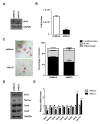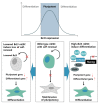Adequate concentration of B cell leukemia/lymphoma 3 (Bcl3) is required for pluripotency and self-renewal of mouse embryonic stem cells via downregulation of Nanog transcription
- PMID: 29335071
- PMCID: PMC5836563
- DOI: 10.5483/bmbrep.2018.51.2.219
Adequate concentration of B cell leukemia/lymphoma 3 (Bcl3) is required for pluripotency and self-renewal of mouse embryonic stem cells via downregulation of Nanog transcription
Abstract
B cell leukemia/lymphoma 3 (Bcl3) plays a pivotal role in immune homeostasis, cellular proliferation, and cell survival, as a co-activator or co-repressor of transcription of the NF-κB family. Recently, it was reported that Bcl3 positively regulates pluripotency genes, including Oct4, in mouse embryonic stem cells (mESCs). However, the role of Bcl3 in the maintenance of pluripotency and self-renewal activity is not fully established. Here, we report the dynamic regulation of the proliferation, pluripotency, and self-renewal of mESCs by Bcl3 via an influence on Nanog transcriptional activity. Bcl3 expression is predominantly observed in immature mESCs, but significantly decreased during cell differentiation by LIF depletion and in mESC-derived EBs. Importantly, the knockdown of Bcl3 resulted in the loss of self-renewal ability and decreased cell proliferation. Similarly, the ectopic expression of Bcl3 also resulted in a significant reduction of proliferation, and the self-renewal of mESCs was demonstrated by alkaline phosphatase staining and clonogenic single cell-derived colony assay. We further examined that Bcl3-mediated regulation of Nanog transcriptional activity in mESCs, which indicated that Bcl3 acts as a transcriptional repressor of Nanog expression in mESCs. In conclusion, we demonstrated that a sufficient concentration of Bcl3 in mESCs plays a critical role in the maintenance of pluripotency and the self-renewal of mESCs via the regulation of Nanog transcriptional activity. [BMB Reports 2018; 51(2): 92-97].
Conflict of interest statement
The authors have no conflicting interests.
Figures




References
Publication types
MeSH terms
Substances
LinkOut - more resources
Full Text Sources
Other Literature Sources
Research Materials

